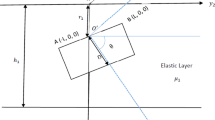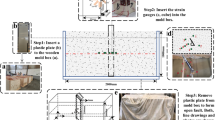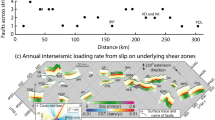Summary
The San Andreas fault can be divided into locked and free sections. On the locked sections accumulated slip is released in great earthquakes. On the free sections slip is occurring continuously either aseismically or during smaller earthquakes. Stress drops during earthquakes can be estimated from the ratio of short to long period amplitudes and from surface strain. Surface heat flow may provide an upper bound on the absolute stress. The failure or yield stress must reach a maximum at some depth on the fault. This maximum may occur in the near-surface brittle zone or deeper in the plastic zone of the fault. The historic distribution of seismic activity provides information on the stress level. The accumulation of strain and stress on the fault can be predicted using elastic theory. It is necessary, however, to include the viscous coupling of the lithosphere to the asthenosphere in order to fully model the problem.
Similar content being viewed by others
References
Atwater, T. andMolnar, P.,Relative motion of the pacific and North American plates deduced from sea floor spreading in the Atlantic, Indian, and South Pacific Oceans, inProceedings of the Conference on Tectonic Problems of the San Andreas Fault System, (eds. R. L. Kovach and A. Nur), (Stanford University Press, Stanford, California, 1973), pp. 136–148.
Bott, M. H. P. andDean, D. S. (1973),Stress diffusion from plate boundaries, Nature243, 339–341.
Brune, J. N. andAllen, C. R. (1967),A low stress-drop low-magnitude earthquake with surface faulting: The Imperial, California, earthquake of March 4 1966, Seis. Soc. Am. Bull.57, 501–514.
Frank, F. C. (1966),Deduction of earth strains from survey data, Seis. Soc. Am. Bull.56, 35–42.
Grantz, A. andDickinson, W. R.,Indicated cumulative offsets along the San Andreas fault in the California Coast Ranges, inProceedings of Conference on Geologic Problems of the San Andreas Fault System, (eds. W. R. Dickinson and A. Grantz), (Stanford University Press, Stanford, California, 1968), pp. 117–120.
Henyey, T. L. andWasserburg, G. J. (1971),Heat flow near major strike-slip faults in California, J. Geophys. Res.76, 7924–7946.
Knopoff, L. (1958),Energy release in earthquakes, Geophys. J. Roy. Astron. Soc.1, 44–52.
Lachenbruch, A. H. andSass, J. H.,Thermo-mechanical aspects of the San Andreas fault system, inProceedings of the Conference on Tectonic Problems of the San Andreas Fault System, (eds. R. L. Kovach and A. Nur), (Stanford University Press, Stanford, California, 1973), pp. 192–214.
Lauderback, G. D. (1947),Central California earthquakes of the 1830's, Seis. Soc. Am. Bull.37, 33–74.
Minster, J. B., Jordan, T. H., Molnar, P. andHaines, E. (1974),Numerical modelling of instantaneous plate tectonics, Geophys. J. Roy. Astron. Soc.36, 541–576.
Savage, J. C. (1975),Comment on ‘An analysis of strain accumulation on a strike-slip fault’ by D. L. Turcotte and D. A. Spence, J. Geophys. Res.80, 4111–4114.
Savage, J. C. (1976), private communication.
Savage, J. C. andBurford, R. O. (1970),Accumulation of tectonic strain in California, Seis. Soc. Am. Bull.60, 1877–1896.
Savage, J. C. andBurford, R. O. (1971),Discussion of paper by C. H. Scholz and T. J. Fitch, ‘Strain accumulation along the San Andreas fault’ J. Geophys. Res.76, 6469–6479.
Savage, J. C. andBurford, R. O. (1973),Geodetic determination of relative plate motion in central California, J. Geophys. Res.78, 832–845.
Spence, D. A. andTurcotte, D. L. (1976),An elastostatic model of stress accumulation on the San Andreas fault, Proc. Roy. Soc. LondonA349, 319–341.
Thatcher, W. (1975a),Strain accumulation and release mechanism of the 1906 San Francisco earthquake, J. Geophys. Res.80, 4862–4872.
Thatcher, W. (1975b),Strain accumulation on the northern San Andreas fault zone since 1906, J. Geophys. Res.80, 4873–4880.
Turcotte, D. L., andSpence, D. A. (1974),An analysis of strain accumulation on a strike-slip fault, J. Geophys. Res.79, 4407–4412.
Wood, H. O. (1955),The 1857 earthquake in California, Seis. Soc. Am. Bull.45, 47–52.
Woodford, A. O. andMcIntyre, D. B. (1976),Curvature of the San Andreas fault, California, Geology4, 573–575.
Wyss, M. andBrune, J. N. (1971),Regional variations of source properties in southern California estimated from the ratio of short-to long-period amplitudes, Seis. Soc. Am. Bull.61, 1153–1167.
Author information
Authors and Affiliations
Rights and permissions
About this article
Cite this article
Turcotte, D.L. Stress accumulation and release on the San Andreas fault. PAGEOPH 115, 413–427 (1977). https://doi.org/10.1007/BF01637118
Received:
Issue Date:
DOI: https://doi.org/10.1007/BF01637118




